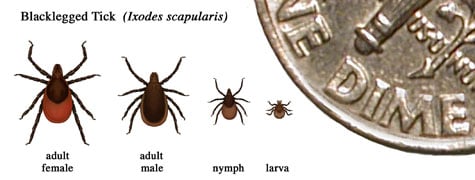
Lyme disease on the rise
Lyme disease incidence is rising in the United States and is in fact far more common than West Nile virus and other insect-borne diseases. Forest fragmentation could explain the increase. Areas of patchy woods, which are very common in cities and suburban and rural areas, may have higher populations of Lyme-disease carrying ticks than forest fragments, which generally have fewer species than continuous habitat. This is because some species thrive in smaller places. National Science Foundation
Is Lyme disease ( in dogs) increasing?
We don't know because we don't have a reporting system similar to that used in humans to track the numbers. But cases in people are increasing, so if we use the humans as a sentinel of canine disease, then we would expect that the numbers of infected dogs are increasing. And areas of transmission also appear to be increasing as the maintenance cycles slowly spread into areas where Lyme borreliosis wasn't previously endemic.
Emerging
A potentially devastating infection ( babesiosis ) caused by tick bites has gained a foothold in the Lower Hudson Valley and in coastal areas of the Northeast, government researchers have found. NYTimes
Lyme disease incidence is rising in the United States and is in fact far more common than West Nile virus and other insect-borne diseases. Forest fragmentation could explain the increase. Areas of patchy woods, which are very common in cities and suburban and rural areas, may have higher populations of Lyme-disease carrying ticks than forest fragments, which generally have fewer species than continuous habitat. This is because some species thrive in smaller places. National Science Foundation
Is Lyme disease ( in dogs) increasing?
We don't know because we don't have a reporting system similar to that used in humans to track the numbers. But cases in people are increasing, so if we use the humans as a sentinel of canine disease, then we would expect that the numbers of infected dogs are increasing. And areas of transmission also appear to be increasing as the maintenance cycles slowly spread into areas where Lyme borreliosis wasn't previously endemic.
Is there any new information or new findings about Lyme disease that veterinarians should know about?We can't afford to stop looking for or considering coinfections once we make that initial diagnosis of a single tick-borne illness, like Lyme disease. If an animal has one tick-related infection, it may well have others. Coinfection should be particularly suspected when a patient fails to respond as expected to treatment for a single diagnosis. Susan E. Little, DVM
Emerging
A potentially devastating infection ( babesiosis ) caused by tick bites has gained a foothold in the Lower Hudson Valley and in coastal areas of the Northeast, government researchers have found. NYTimes











